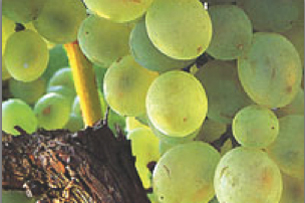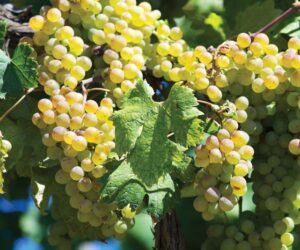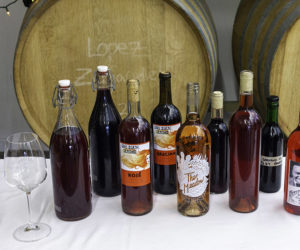
Grown originally in the Charente region of southwest France, Colombard is often used as a blending grape for table wine or as a base wine in the distillation process for Armagnac (brandy). In the United States it produces a bountiful crop that provides value priced wine known as French Colombard as well as a base wine for distillation and as a base wine used for blending with many other white wines. Colombard blends well with Chardonnay, Chenin Blanc, Riesling, Sauvignon Blanc, Semillon and Shiraz.
While it is known to grow very well in dry, hot California climates, it also is grown in Mendocino, Russian River Valley and the Suisun Valley.
Harvesting at the peak of ripeness is the key to fully developed flavors for all wine grapes. Colombard has the capability of producing recognizable aromas and flavors of peach, melon, tangerine, tropical fruit, apple, citrus, mineral and a hint of spice when it is harvested at 23–24 °Brix. At 22 °Brix it can produce delicate still wines with crisp acidity or an inexpensive sparkling wine. With these inviting wine descriptors, everyone could be tempted with a glass of Colombard and a plate of cheese, a hearty salad or a platter of shrimp. As an economical beverage, Colombard seems to fit into every budget.
Consider making Colombard white wine this year when grapes and juice are available at the green grocer in September and October. If you wish to have more control of the quality, inspect crates of fresh grapes before purchase. Use a sugar refractometer and test a few of the grapes from each crate to be purchased. Remember 22 to 24 °Brix is a desirable refractometer reading. Less than ripe Colombard may produce a fairly neutral wine or can exhibit aromas and flavors reminiscent of Sauvignon Blanc (asparagus, rhubarb, gooseberry, boxwood or ammonia).
Crush the grapes as soon as possible. Treat the grape skins and juice with pectic enzyme several hours before pressing. This is known as maceration, or, a period of time that the skins and seeds are in contact with the juice. Maceration is a red grape skin technique but can be used with white grapes to help extract esters that will hopefully produce more complex flavors as well as more color. Care must be taken so that the length of time white grapes are in contact with the juice is relatively short. Excessive tannin extraction from the skins and seeds is not desirable in a white wine. The must is exposed to the air during this time and can cause some oxidization. Refrigerating the must during this period of cold maceration (41–59 °F /5–15 °C) will help to keep the fruit fresh. If refrigeration is not an option, try to keep the fruit at 60 °F (15 °C). A layer or “blanket” of carbon dioxide (CO2) can also be used to help prevent oxidation when the must is in a sealed fermenter. Of course, caution must also be used when working with carbon dioxide since it can take your breath away. Ferment at 65–70 °F (18–21 °C) using a low foaming yeast (see our recipe for suggestions). Once the fermentation kicks off well (an initial hydrometer reading of 22 °Brix that progresses to a reading of 17 °Brix), the temperature can be slowly lowered to 60 °F (15 °C) to help preserve the delicate aromatic character and flavor. Be sure to use an acid test kit to titrate the acidity of the juice.
Fresh buckets of juice may have widely different acid readings depending upon the producer’s standards. A typical acidity reading will be 0.8 TA (total acidity). Clarify and chill the fermented Colombard for several weeks at 32–35 °F (0–2 °C) to cold stabilize the wine. Col-ombard is usually sold as a dry or semi-dry wine, sometimes with a kiss of oak. You may wish to add a little oak (toasted or not) to the fermenting or finished wine for additional complexity. After the wine is racked several times away from the sediment, taste it to assess the flavors to determine if you wish to add residual sugar (and potassium sorbate) to balance the crisp acid aftertaste. You may wish to compare and contrast the flavors to Sauvignon Blanc. You may find this to be yet another chilled white to savor with your evening meal. Cheers!
Colombard Recipe
Colombard Recipe
(6 gallons/23 L)
Ingredients:
84 lbs. (~38 kg) fresh Colombard grapes or a 6-gallon (23-L) bucket of fresh Colombard juice
18 drops liquid pectic enzyme or appropriate equivalent of dry pectic enzyme for 6-gallons (23 L)
A total of 15 Campden tablets or 15 teaspoons sulfite solution*
1 packet yeast Lalvin 71B-1122, EC-1118 or D-47, Red Star Côte des Blancs, Premier Cuvée (Prise de Mousse)
6 tsp. complete yeast nutrient
bentonite for fining
Optional addition:
1 oz. (28 g) granular or oak chips (untoasted, light or medium toast)
rice hulls at pressing (1 lb. or 0.45 kg rice hulls per 100 lbs. or 45 kg grapes)
If sweetening the finished wine: cane sugar and potassium sorbate
* Sulfite is added before and after fermentation and again at racking. Typical dosage is 1 Campden tablet per gallon (3.8 L), or if using a sulfite solution, 1 teaspoon liquid sulfite solution per gallon (3.8 L) of must or wine.
To make a sulfite solution: To 1 cup of water add 1 oz. potassium metabisulfite. Stir to dissolve. Use 1 teaspoon sulfite solution for each gallon (3.8 L) of juice or wine. (Store metabisulfite solution in a glass jar with the lid lined with plastic wrap to avoid interaction with the metal. Label the jar “sulfite solution for wine” and place a “Mr. Yuk” sticker on it. Store the sulfite solution on a shelf and out of the reach of children.
Step by step:
1. Sanitize all of your winemaking equipment.
2. Inspect the grapes and remove all spoiled grapes from the stems and discard. Crush the grapes. Remove as many stems as possible.
3. Add pectic enzyme to the crushed grapes. Mix thoroughly.
4. Add 5 Campden tablets (crushed and dissolved) or 5 teaspoons sulfite solution.
5. Cover container and let set for several hours before pressing. Refrigerate must, if possible (41–59 °F or 5–15 °C).
6. Lightly press grapes to avoid crushing the seeds. Use rice hulls (to increase yield without increasing pressure).
7. Place juice in a primary fermenter (food grade container).
8. When the must reaches 60 °F (16 °C), use a hydrometer to test for sugar (Brix). Record the reading. If needed, add sugar to reach 22 °Brix.
9. Take an acidity reading using an acid test kit. Record the total acidity (TA). If the acidity is too high (1.0 or higher), reduce acidity prior to fermentation by ameliorating (dilution with water) or after fermentation with potassium bicarbonate and cold stabilization.
10. Cover the must. Keep in a cool area (65–70 °F or 18–21 °C) for 24 hours. Allow the must to come to 65–70 °F (18–21 °C) if possible. Rack the juice away from the sediment using a siphon system (racking cane and food grade tubing). Discard the sediment to reduce the chance of off-odors during fermentation.
11. Hydrate the yeast. Sprinkle the yeast over 1/4 cup (4 ounces/120 ml) warm water (do not exceed 105 °F or 40 °C). Let stand for 5 to 10 minutes. Stir then add to the must.
12. Add complete yeast nutrient to a small amount of must. Stir to dissolve. Add to the must. Stir thoroughly. Cover the fermenter loosely with a sheet of plastic or the fermenter lid.
13. Optional: Add the oak now or after fermentation has finished.
14. Fermentation will begin in two or three days. Take a hydrometer reading every 2 to 4 days. Record the reading in your record book.
15. When the hydrometer reading is 8 °Brix or 1.030 SG, transfer the wine (with the sediment) using a siphon system into a glass carboy. Attach a rubber stopper and airlock (filled with 1 oz. or 30 mL water).
16. Allow the wine to ferment to dryness. The hydrometer reading will be 0 to -1.5 °Brix or 1.000 to 0.992 SG. Sulfite the wine by adding 5 Campden tablets or 5 teaspoons sulfite solution.
17. Add bentonite (following manufacturer’s directions) to clarify the wine.
18. After a month to six weeks, rack the wine away from the lees (sediment) into a sanitized carboy. Add 5 Campden tablets (crushed and dissolved in a little of the wine) or 5 teaspoons sulfite solution. Stir thoroughly. Reattach the airlock (filled with fresh or distilled water) and rubber stopper in the neck of the carboy.
19. Keep the wine in a cool area, if possible, to hasten the dropout of sediment.
20. After another month to six weeks, rack the wine away from the lees and into a sanitized carboy. Reattach the airlock and stopper. Taste the wine. The yeasty taste will most likely be gone after this second racking and the Colombard flavors should be evident.
21. After another month to six weeks, rack the wine one more time into a sanitized carboy.
22. Check acidity using an acid test kit. Taste the wine. If the wine is too tart, consider adding sugar to balance the acidity or cold stabilize the wine and use potassium bicarbonate to reduce the acidity.
23. Determine if you wish to bottle the wine as a dry wine or if you wish to sweeten the wine by adding cane sugar and potassium sorbate (per manufacturer’s directions). If you wish to sweeten the wine, add as little as 1/2 oz. (14 g) but probably not more than 3 oz. (64 g) cane sugar to 1 quart (~ 1 L) of wine to taste. If you like the finished product, add the appropriate amount of sugar to the remaining wine.
24. Check the sulfite level of the wine. Add additional Campden tablets or sulfite solution to maintain 35 to 45 ppm.
25. Filter the wine for a brilliant appearance.
26. Sanitize bottles and all equipment used for bottling. Bottle the wine, leaving no more than 1/2 inch (~1.25 cm) air space in the bottle. Allow bottles to sit upright 7 to 10 days before resting the bottle lengthwise on the wine rack. Cheers!
Colombard and food pairing: antipasto, cheeses (brick, edam, gouda, havarti, muenster, Swiss), chilled soups, seafood, oysters, lobster, shrimp, clams, crab, fried fish, green salad, chicken salad, fried chicken, Oriental/Asian/Thai or Mexican food, sweet & sour sauces.




